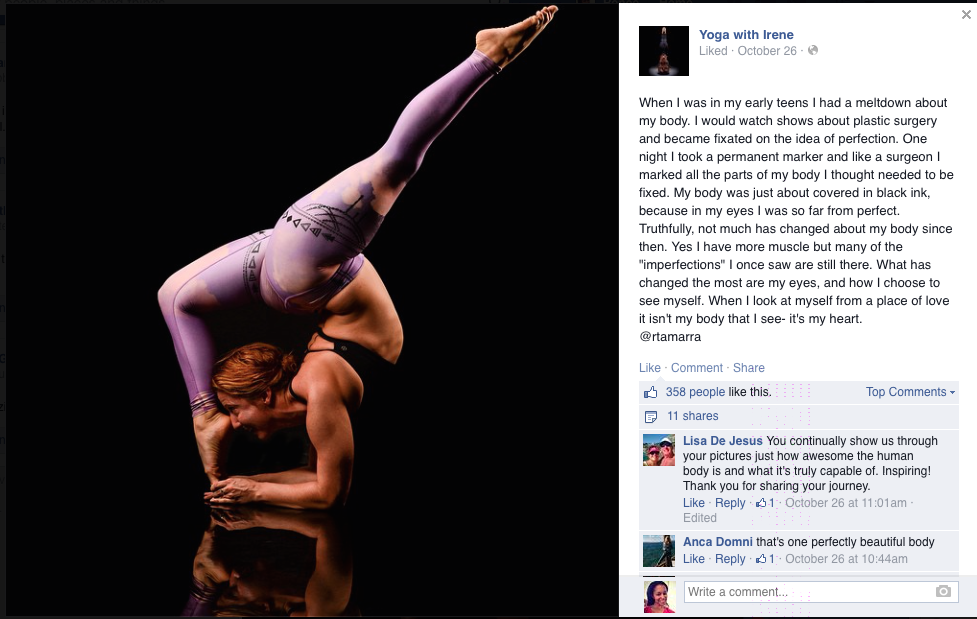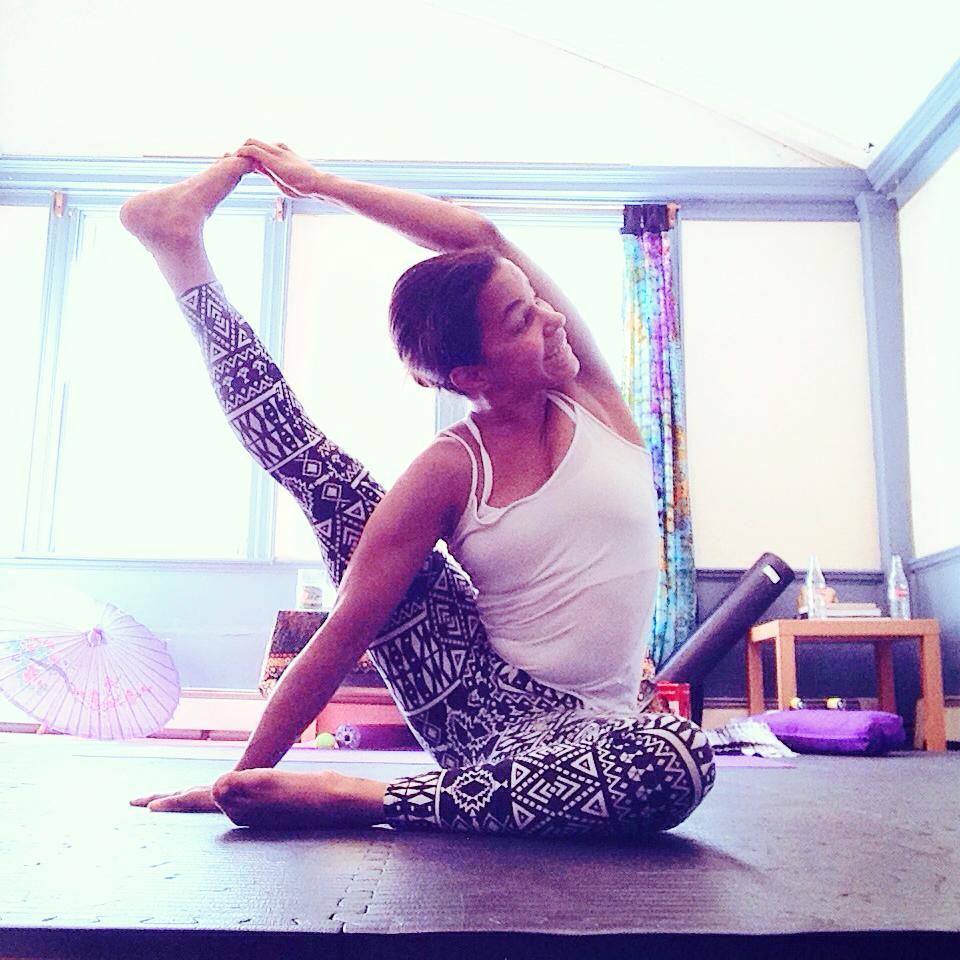 The yoga community has been increasingly abuzz about body image ever since Lulemon, a darling of the yoga fashion world, was singled out for scrutiny in 2013 for not offering yoga attire beyond size 12. The criticism struck a nerve within a community that more than a few feel is more exclusive than inclusive—at least in mainstream culture. Vocal critics looking across clothing lines and media depictions have found that representations of the diversity of yoga practitioners—in body size, race, age and even gender—is, in general, lacking.
The yoga community has been increasingly abuzz about body image ever since Lulemon, a darling of the yoga fashion world, was singled out for scrutiny in 2013 for not offering yoga attire beyond size 12. The criticism struck a nerve within a community that more than a few feel is more exclusive than inclusive—at least in mainstream culture. Vocal critics looking across clothing lines and media depictions have found that representations of the diversity of yoga practitioners—in body size, race, age and even gender—is, in general, lacking.
In the October issue of Yoga Journal that addressed the theme of body image, yoga teacher and writer Kathryn Budig discusses the “long and sinewy” yoga body aesthetic. With a cover photo that doesn’t attempt to sleek down her middle, Budig said how she is constantly called brave, simply for showing her curvy body to the world. As part of a recent Instagram challenge, Budig posted favorite pictures of herself on the beach—cellulite and all. She encouraged other participants to also post photos of themselves they loved but felt some body part didn’t quite look right in the photo. (Interestingly, Yoga Journal shares Budig’s cellulite-free, naked ad for ToeSox earlier in the issue.)
Still Budig, author of the new book, Aim True, isn’t immune to occasional negative self-talk and the changes of aging. “[I]t has been a challenge to watch my 25-year-old body turn into a 32-year-old body,” she said, describing it positively as an evolution of woman. “This body, whether it is 10 pounds skinnier or 10 pounds heavier, can still do these postures because it so strong.” Budig says she stays focused on the results and how she feels.
“If you have a body, you have a yoga body—no matter what your size, age, race or ethnicity, ability, socioeconomic status, sexual orientation, or gender identity,” said sociologist Melanie Klein, cofounder of Yoga and Body Image Coalition, in a recent interview with Yoga International. The Coalition is challenging the yoga industry to create representative content that does not exclude 95 percent of the population, as “the image of the ‘yoga body’ perpetuated in yoga media and culture is incredibly one-dimensional and exclusive.”
With Instagram (IG) as my biggest (social) media source for yoga inspiration, however, I am bombarded with yogis of all different ages, ethnicities and body types—and I follow a large number of men, as well as women. I have friends who practice yoga naked and others who practice yoga in their pajamas. I follow effervescent, 12-year-old California girl Jaysea Devoe, considered the youngest certified yoga teacher in the country, and I follow an unknown woman in her 50s, who decided it’s never too late to embrace the health benefits of the yoga practice and is slowly learning, pose by pose. I admire tall, willowy yogis who astound me by folding themselves in half backwards, and I’m equally amazed by my extra curvy pals who can hold steady in standing balance poses with more confidence than I feel I’ll ever have.
Yet, even amongst all this diversity, the frequent focus on perfection in poses and flashy photographs on IG, along with a constantly aware audience, I find myself retaking photos of myself so that no fold of skin pokes out too noticeably or to replace my face of effort with a smile. My inner critic wants to delete the photos that display the body’s imperfections despite the beauty of a pose. Instagram superstar @LauraSykora, with more than 1 million followers, always rocks great alignment, never has an unflattering bulge, always has the perfect outfit on, and never has a hair out of place. But yoga isn’t a beauty contest—it’s all about the practice and the progress…right?
 One of my favorite IG yogis with an incredibly strong and flexible practice, Irene Pappas, aka @FitQueenIrene, recently opened up about her own struggle with body image. As a teen, she said she became fixated with plastic surgery and perfection, covering her body with marker ink where she felt it needed fixing. “Truthfully, not much has changed about my body since then,” Pappas wrote on her Facebook page, Yoga With Irene. “Yes I have more muscle but many of the ‘imperfections’ I once saw are still there. What has changed the most are my eyes, and how I choose to see myself. When I look at myself from a place of love it isn’t my body that I see—it’s my heart.”
One of my favorite IG yogis with an incredibly strong and flexible practice, Irene Pappas, aka @FitQueenIrene, recently opened up about her own struggle with body image. As a teen, she said she became fixated with plastic surgery and perfection, covering her body with marker ink where she felt it needed fixing. “Truthfully, not much has changed about my body since then,” Pappas wrote on her Facebook page, Yoga With Irene. “Yes I have more muscle but many of the ‘imperfections’ I once saw are still there. What has changed the most are my eyes, and how I choose to see myself. When I look at myself from a place of love it isn’t my body that I see—it’s my heart.”
The new book, Yoga and Body Image shares 25 personal stories from a diverse group of yoga teachers and practitioners, offering refreshing perspective on loving the body. As a self-described “fat, black yoga teacher,” the experiences Dianne Boundy (http://yogasteya.com), had with discrimination taught her that she “needed to create a diverse yoga space, help grow diverse teachers, and do my part in making yoga more accessible.”
Linda Sparrowe, former Yoga Journal editor and co-author of The Woman’s Book of Yoga and Health, believes the aging body also needs to be represented and that older yoga teachers can be strong and wise role models. “When yoga teachers are ashamed of their aging bodies, they send a pretty powerful message that says being young, thin, and hip are all that matters,” she writes. “Instead [teachers] need to present themselves fully—wrinkles, gray hair, laugh lines, and all…”
“I had done yoga for seven years before I saw someone else who looked like me. Oh, not in class. In a book. It took another three years before I did yoga side by side with other curvy-bodied practitioners,” Anna Guest-Jelley, founder of Curvy Yoga, writes in Yoga International. “I learned firsthand how rare it is to feel solidarity with others in the room.”
While labels tend to ruffle my feathers, I have to admit it felt affirming when I first discovered other women who looked like me doing yoga. There were other women who had my body type and perhaps had similar approaches to certain poses as I did. And as a woman with an autoimmune disease and a neuromuscular movement disorder, dystonia, finding other athletes overcoming similar health challenges was extremely encouraging and motivating.
In Yoga and Body Image, Joni Kung remembers initially feeling out of place doing yoga as “a short, middle-aged, average looking Asian woman” in a studio full of thin, attractive, white people. Yet after years of practice, she realized, “Yoga isn’t about looking your yoga, it’s about living your yoga.”
Yoga instructor Sariane Leigh, aka Anacostia Yogi, agrees. “Yoga and stillness have taught me that there is so much more to this human form, and to asana, than conflicting cultural messages about beauty, fitness, and health imply,” she said in an interview with Yoga International. “I think collectively people are starting to find their own middle ground. More people are redefining health and beauty regardless of stereotypes or marketing messages. The next step is to allow yoga to do its job and represent the spiritual evolution of the mind and body.”
And that means embracing the truth that every body is a yoga body. We show up to the mat. We start where we are. We modify poses to fit our varied abilities. We stop worrying about the photo and take pleasure in the practice, finding peace, balance and strength—inside and out—through the breath and the flow.

Interesting read! Negative self-talk and negative body image are give-ins for so many women…. Including myself. :/
It’s sad that so many of us do it so unconsciously and steadily! We need to stay more alert to the things we tell ourselves and the constant stream of (not-so-)subtle, external messages that question our worth. Recognize them for what they are and dump them from our brains. (I can’t but think that turning off the TV and leaving the magazines behind can help!)
Thanks for reading
I’m reading that issue of Yoga Journal now. I’ve been a subscriber for years and know that they’ve had letters to the editor commenting on the lack of diversity in their advertising and models. The ToeSox ads have been running for years. I’ll have to go back and look at this month’s. Is Budig their regular model? Just this issue I was thinking, Will this woman ever age out of this modeling gig?
Gail, yes Budig is ToeSox’s regular model, as far as I can tell. I think it’s cool if she can still rock it. I agree that it would be great to see more diversity in their models–age, shape, etc.
I agree that it would be great to see more diversity in their models–age, shape, etc.
I like this, “…embracing the truth that every body is a yoga body”. It would be nice if people can just exercise without living up to crazy societal expectations.
Cecilia, how freeing it would be to exercise our own bodies for movement’s sake alone! I think it’s possible, but we have to be bold enough to clear our minds and just *feel* our bodies!
Great post. I practice yoga at many studios throughout NYC and in CT and I see people of all shapes and sizes. I love the quote “If you have a body, you have a yoga body” because anyone can do yoga, as long as you put your mind and body to it.
Thanks, Denise. I love how just about *any* body can find a way to do yoga. Was such a liberating realization for me!
Loved this post and this quote “Yoga isn’t about looking your yoga, it’s about living your yoga.”
Thanks for reading! I love that quote as well: “living your yoga.” It’s truly a joy learning increasingly more every day what that truly means
Males and anyone over 50 do not exist in Yoga Journal’s eyes. Very sad.
It is quite sad and not at all representative of the overall yoga community. I think YJ and other yoga-centric media would be pleasantly surprised by the public response to more inclusive representations of the yoga community…but that’s just a hunch.